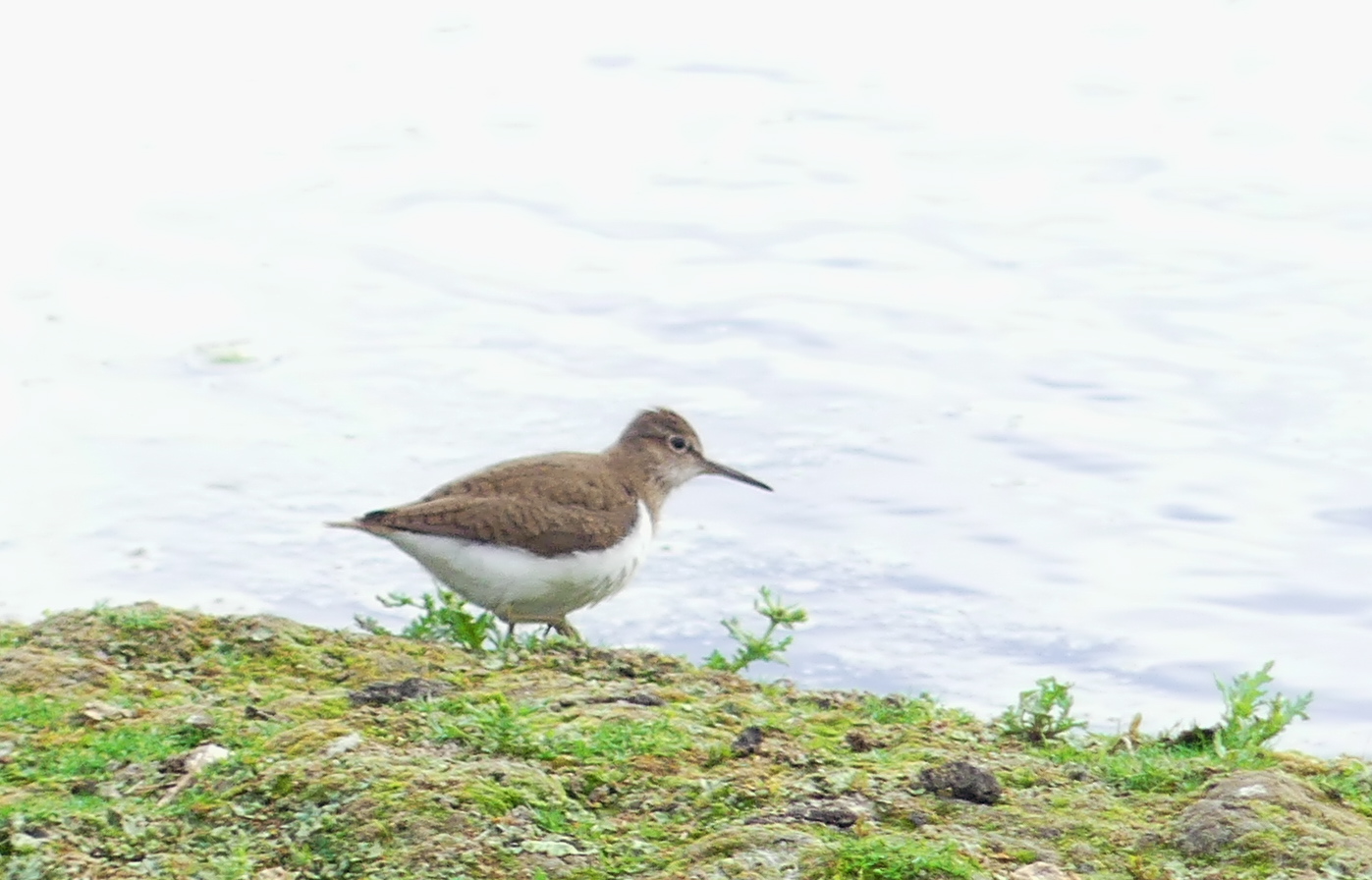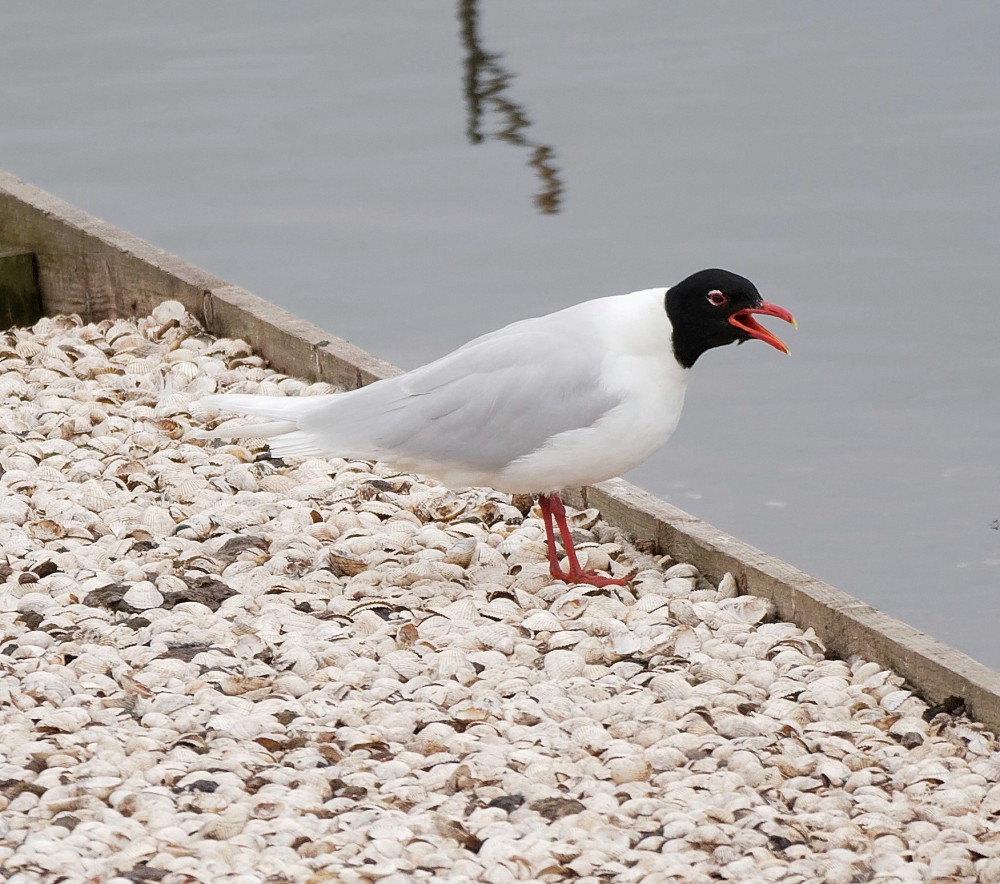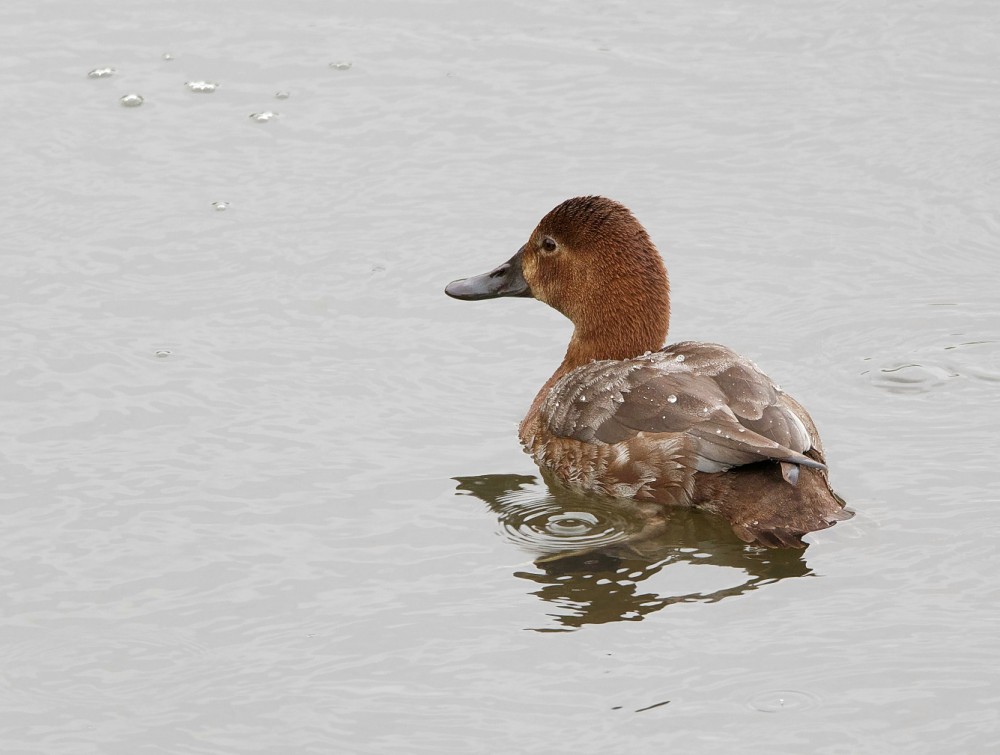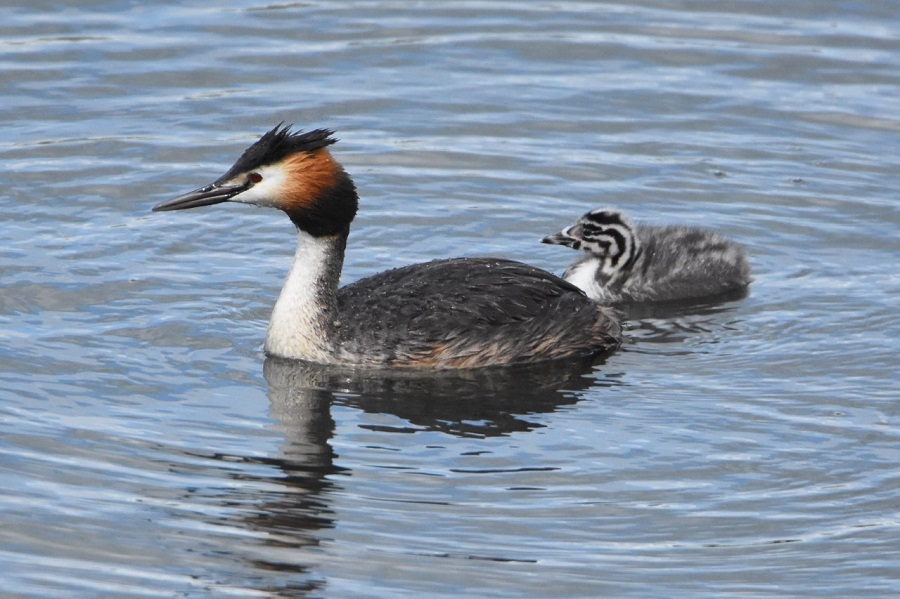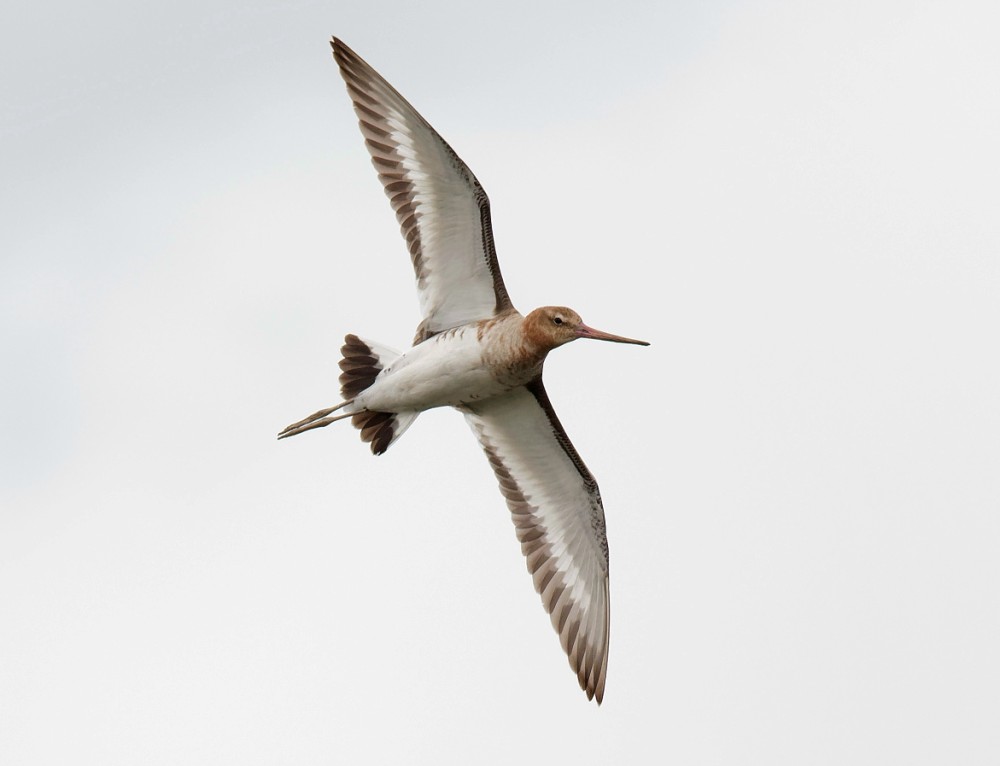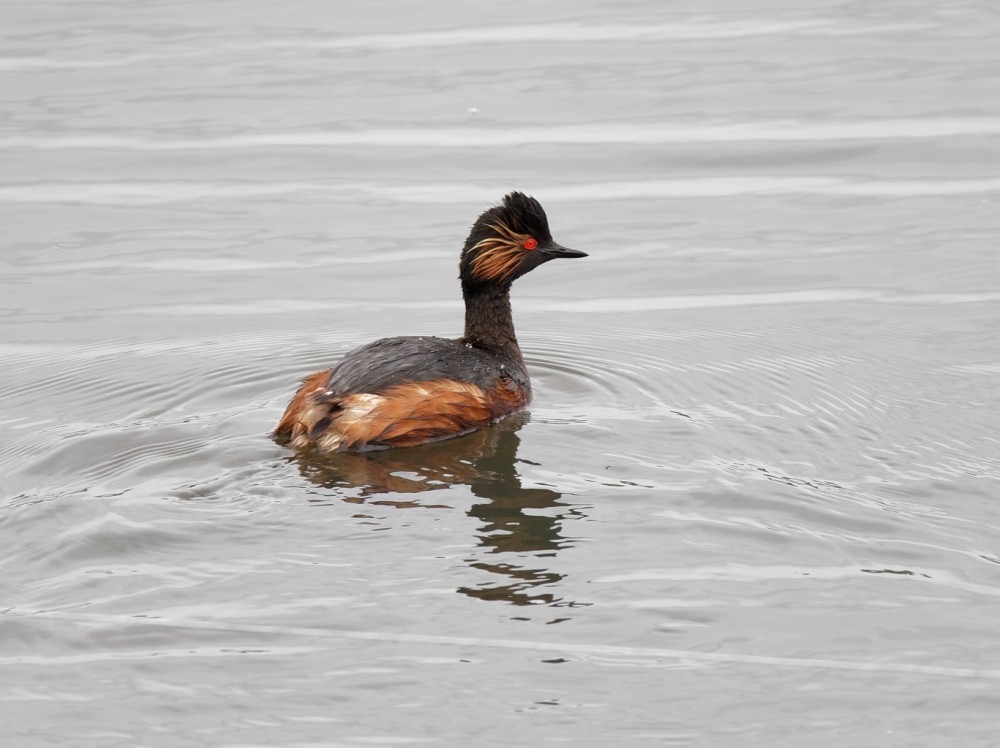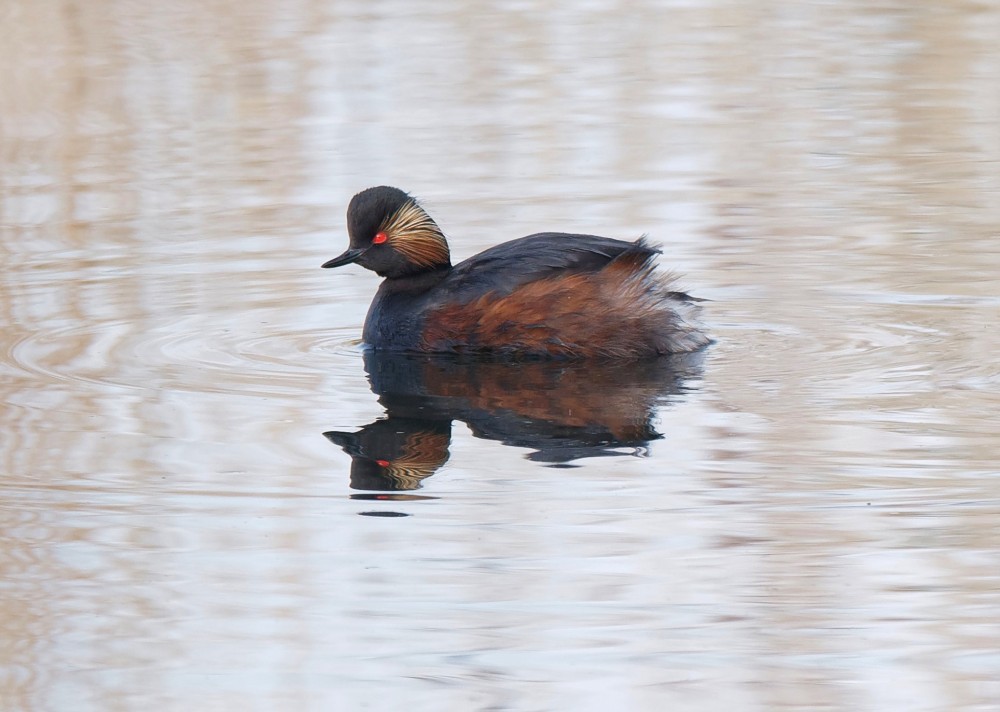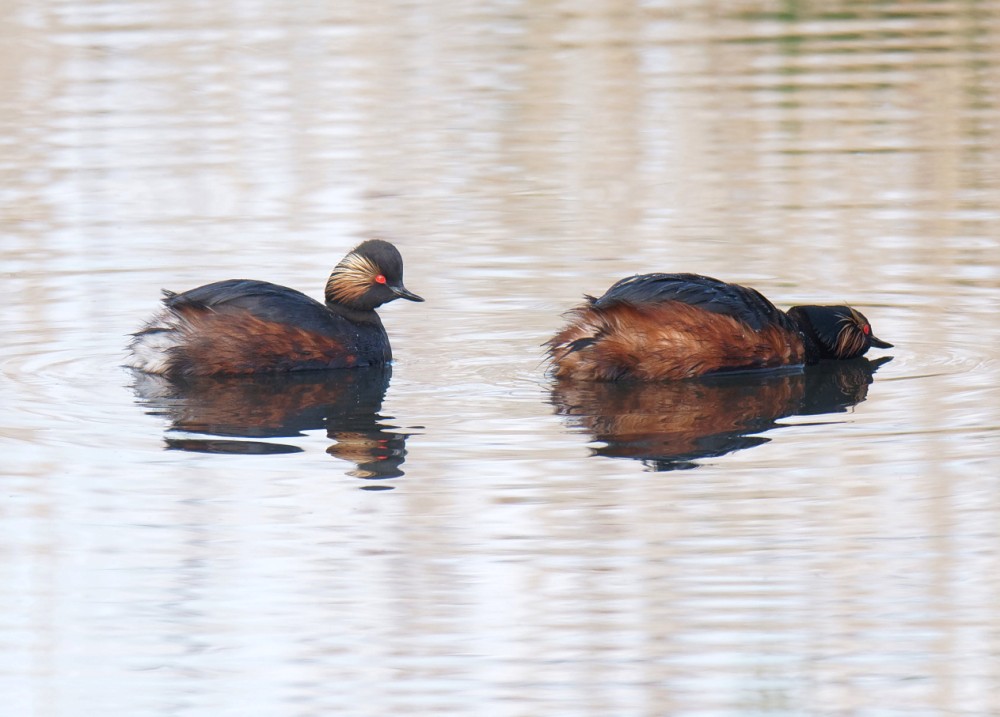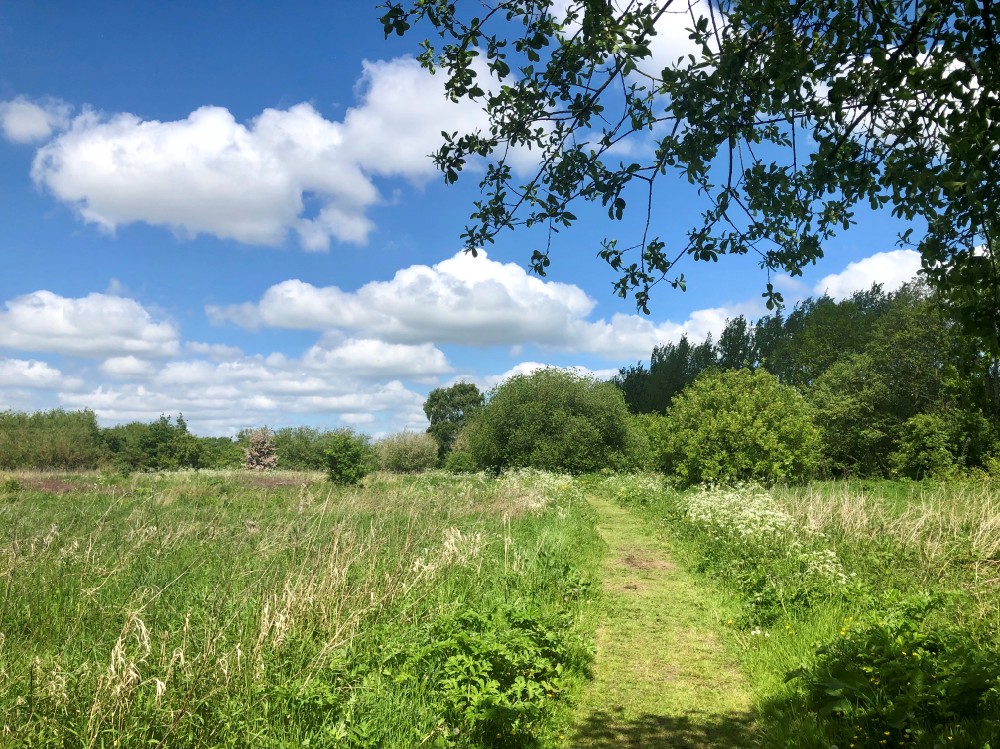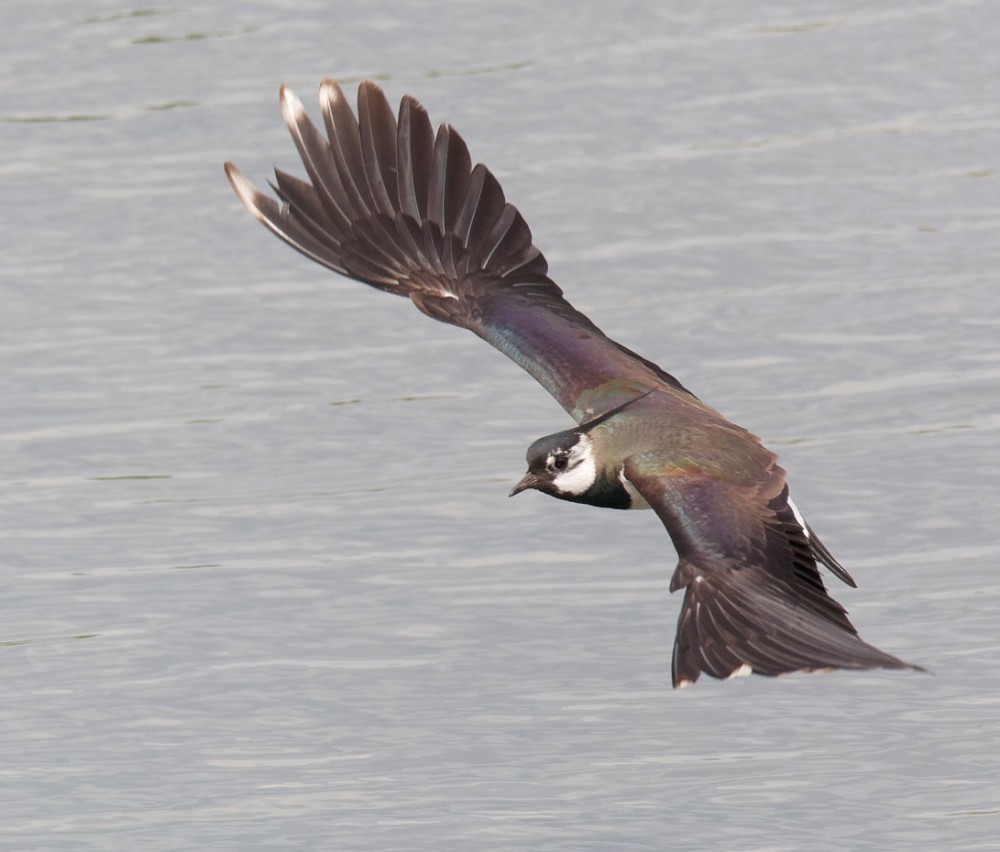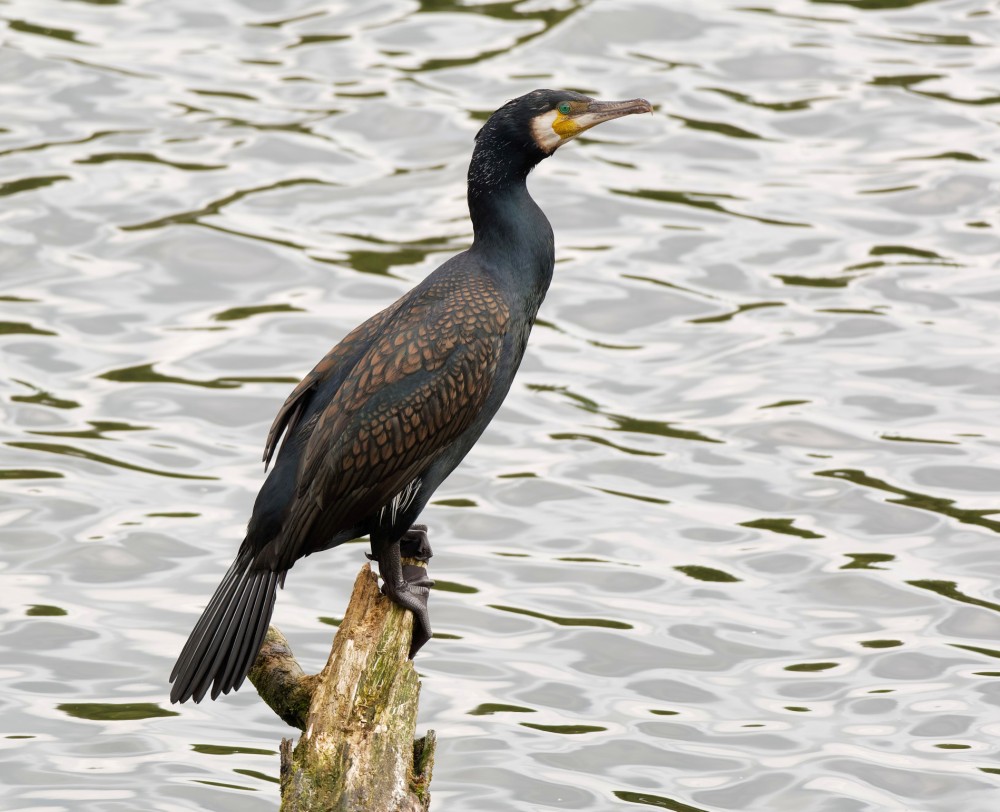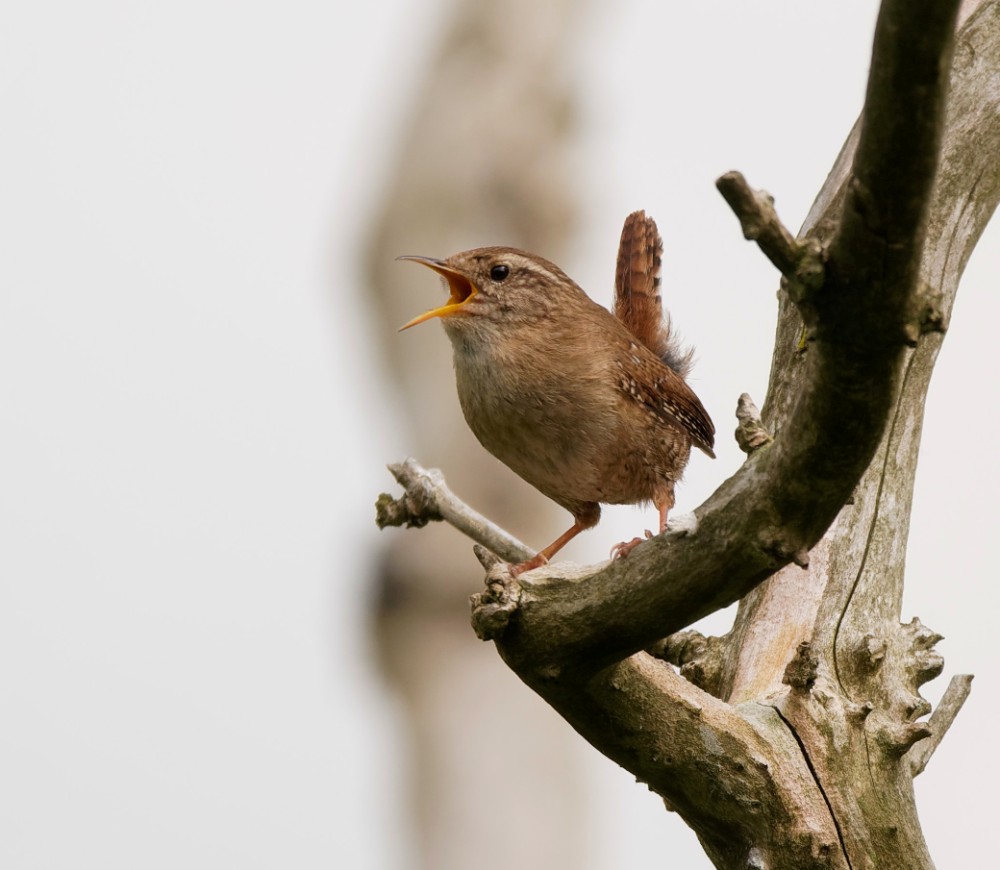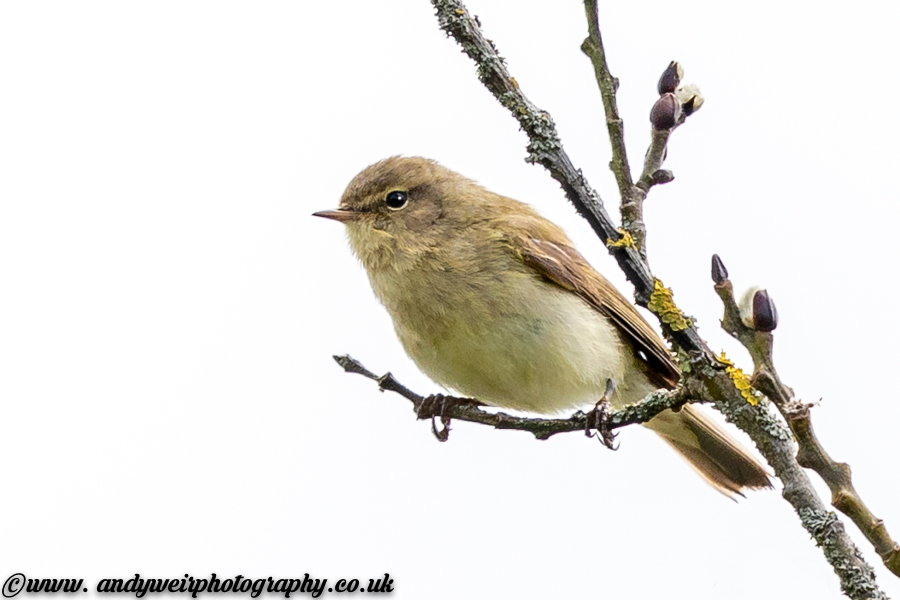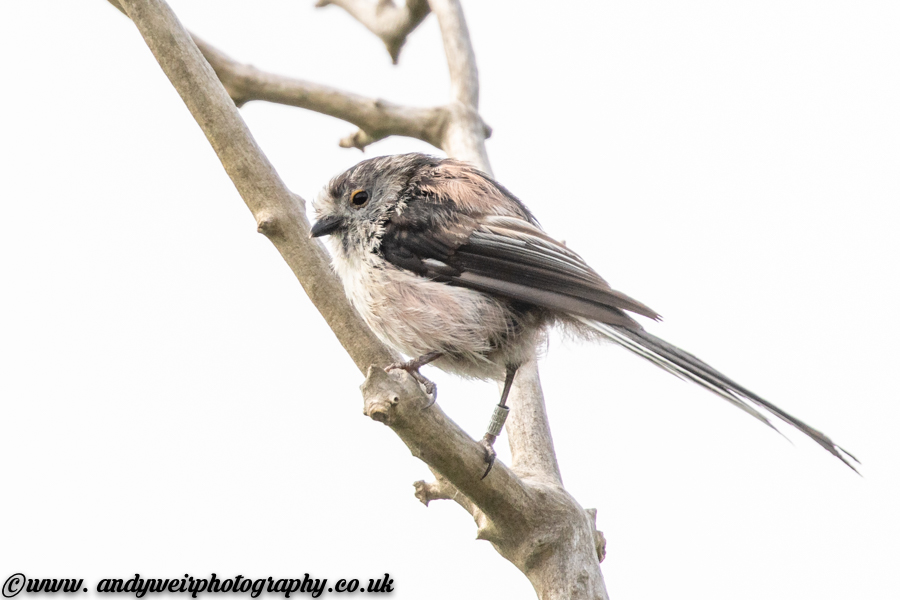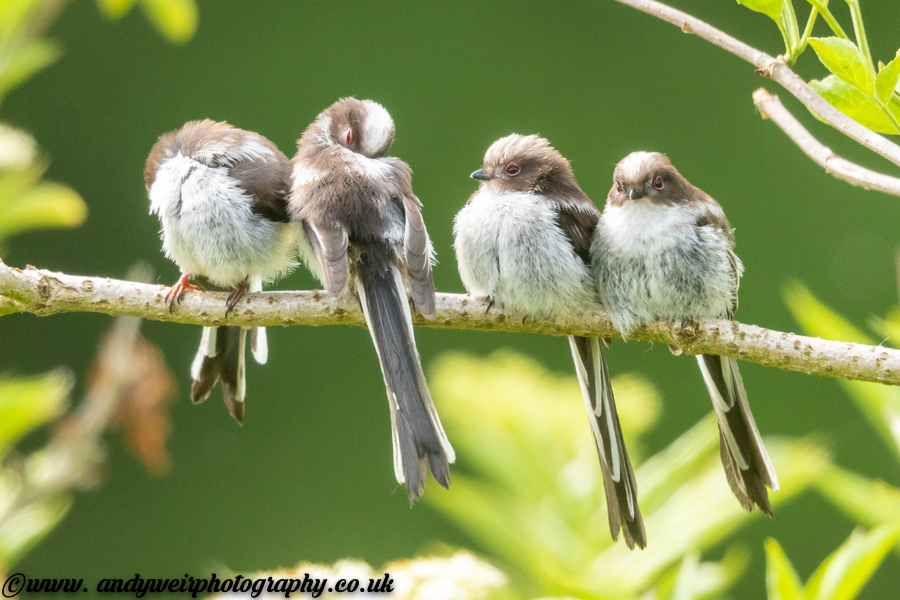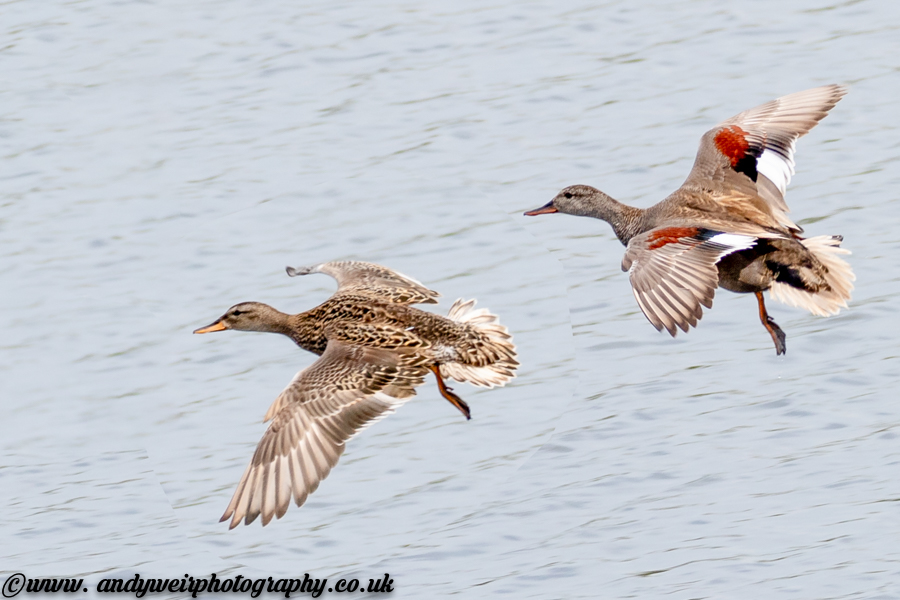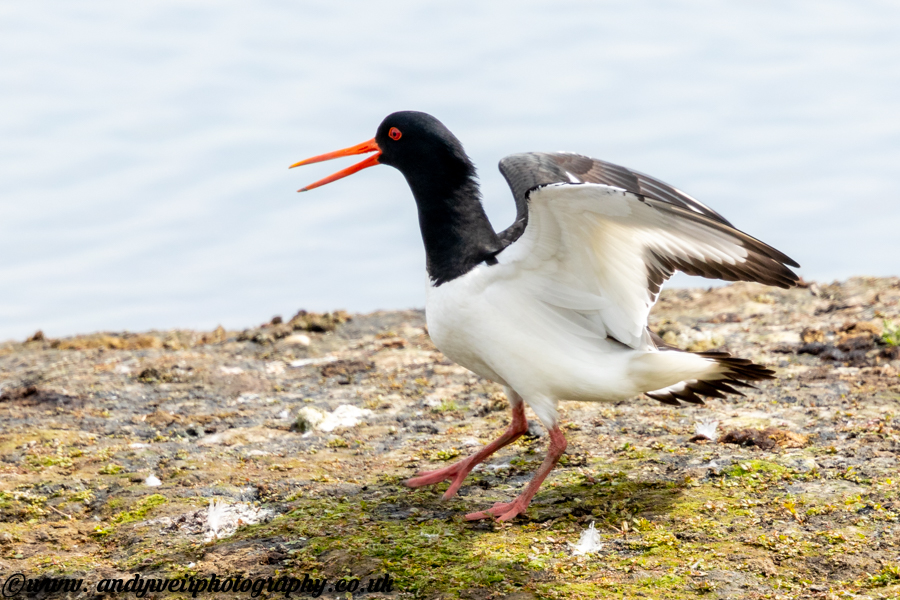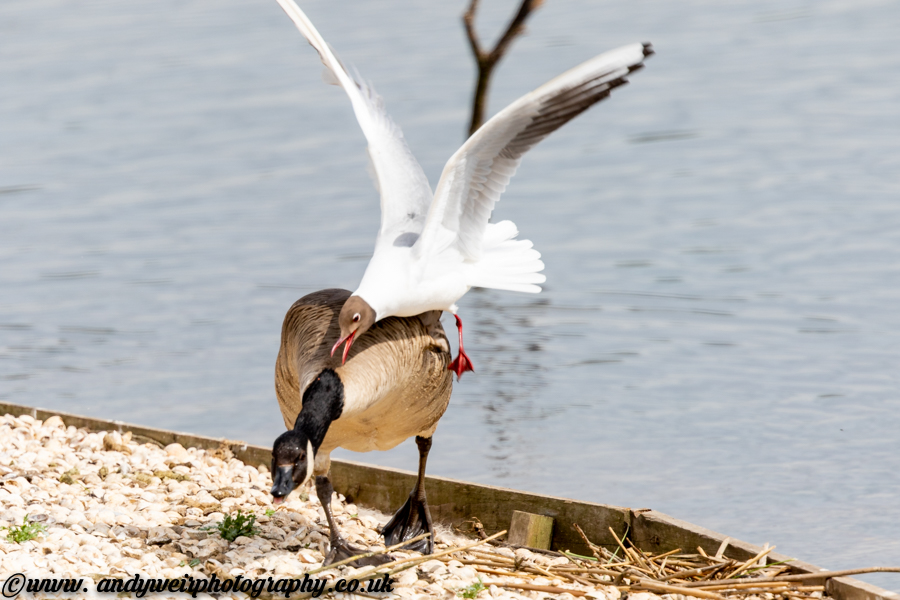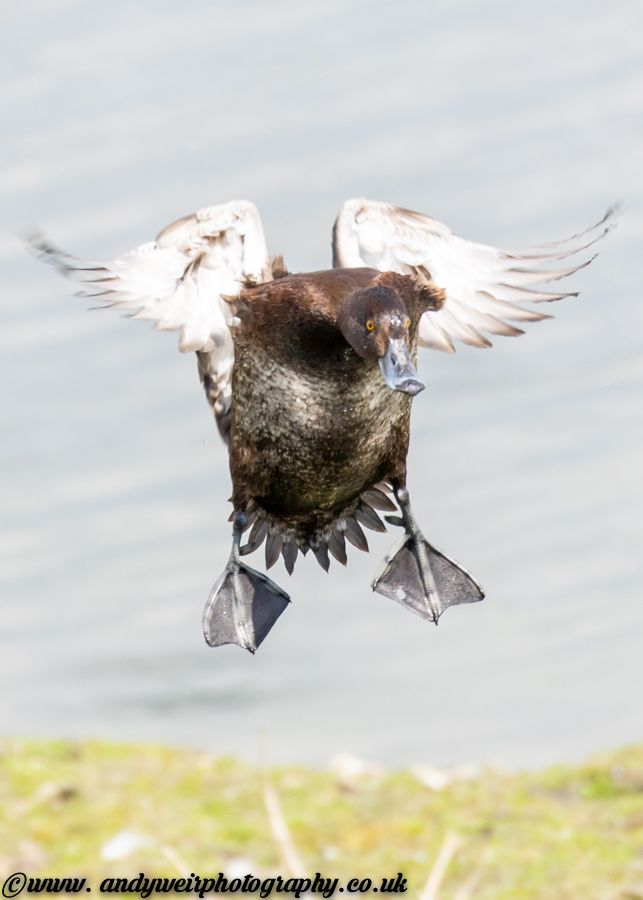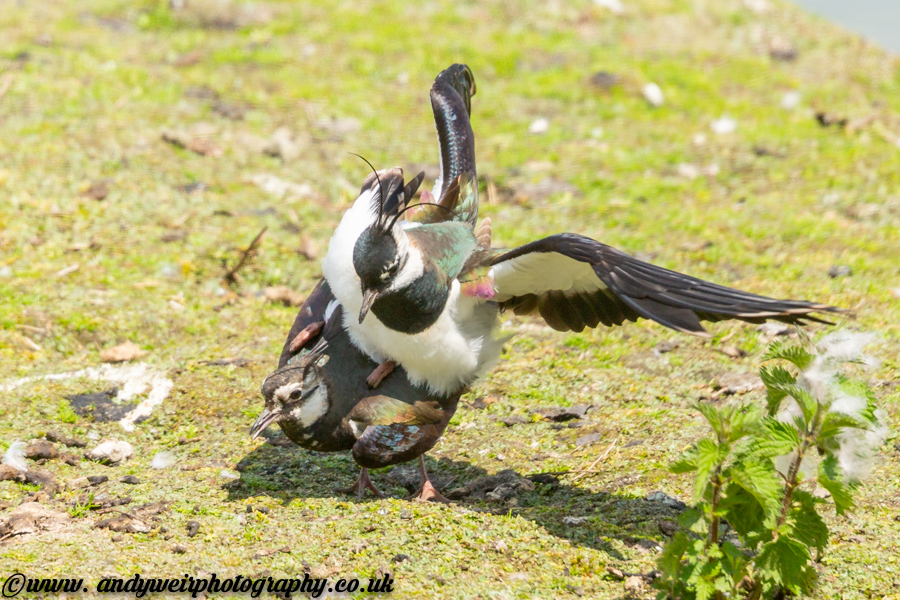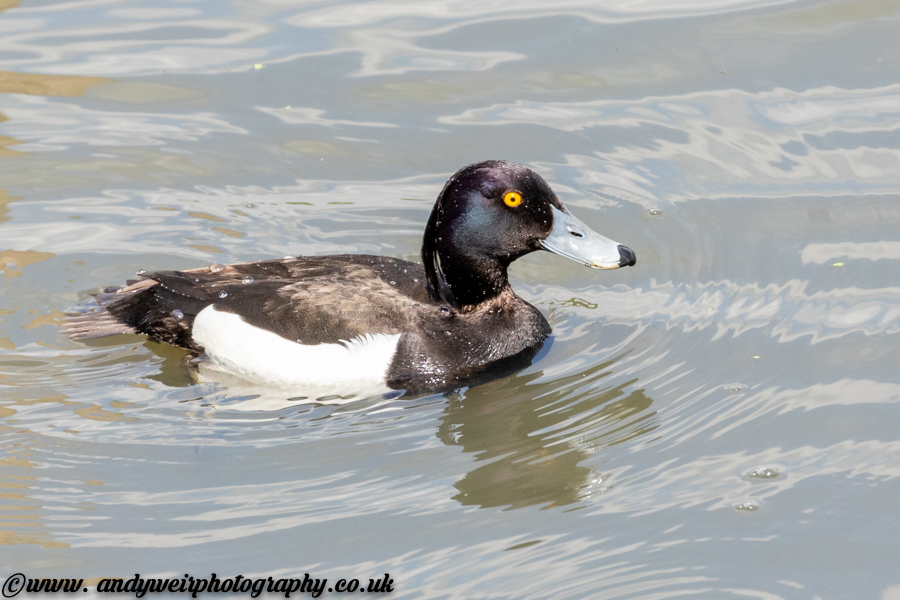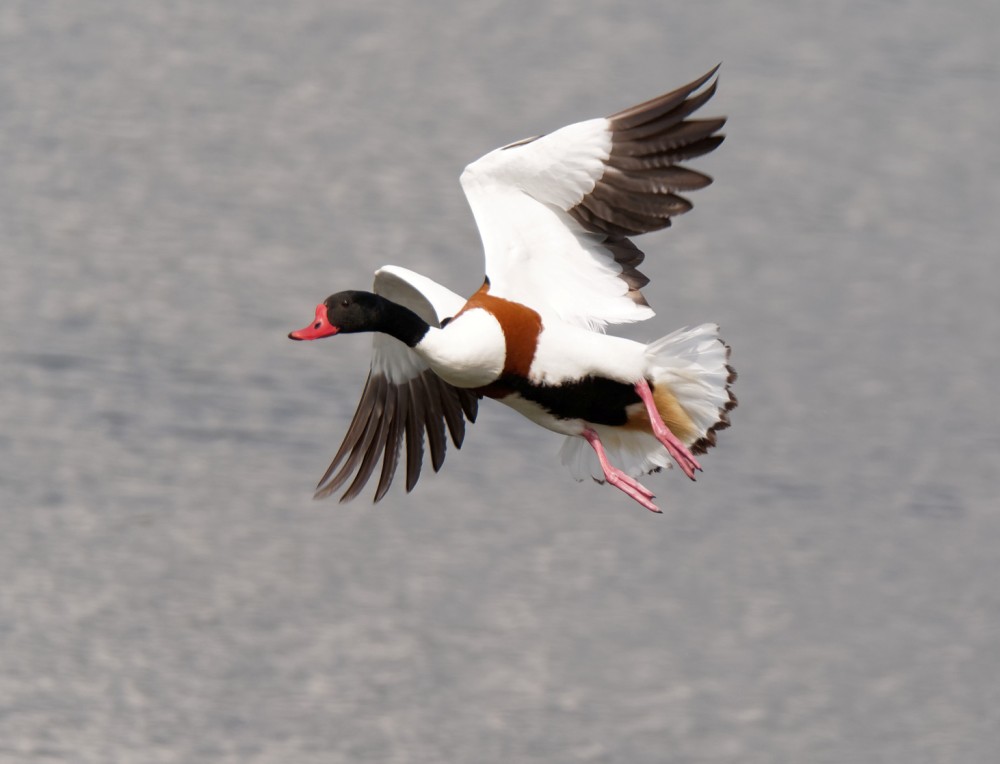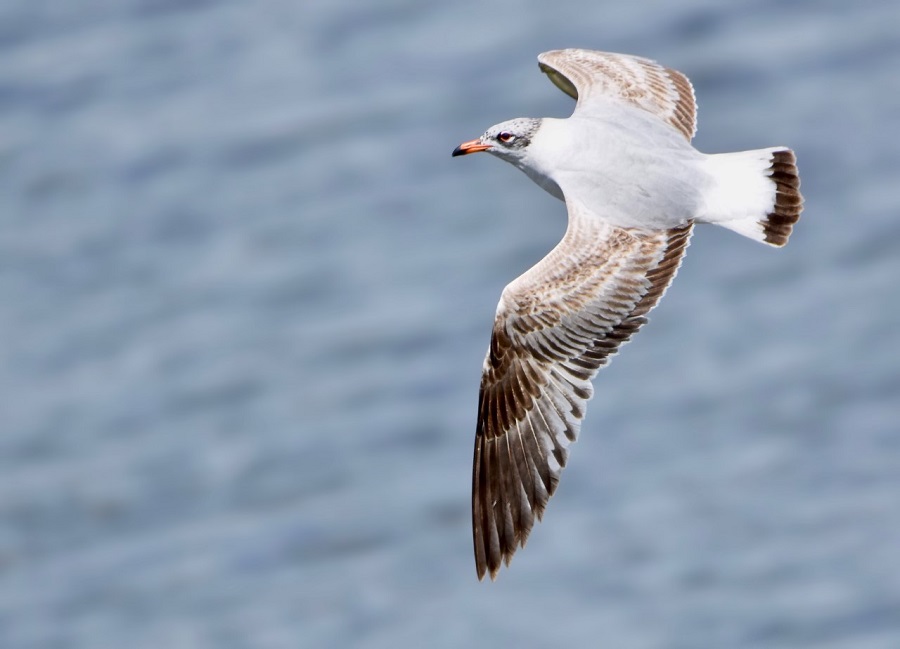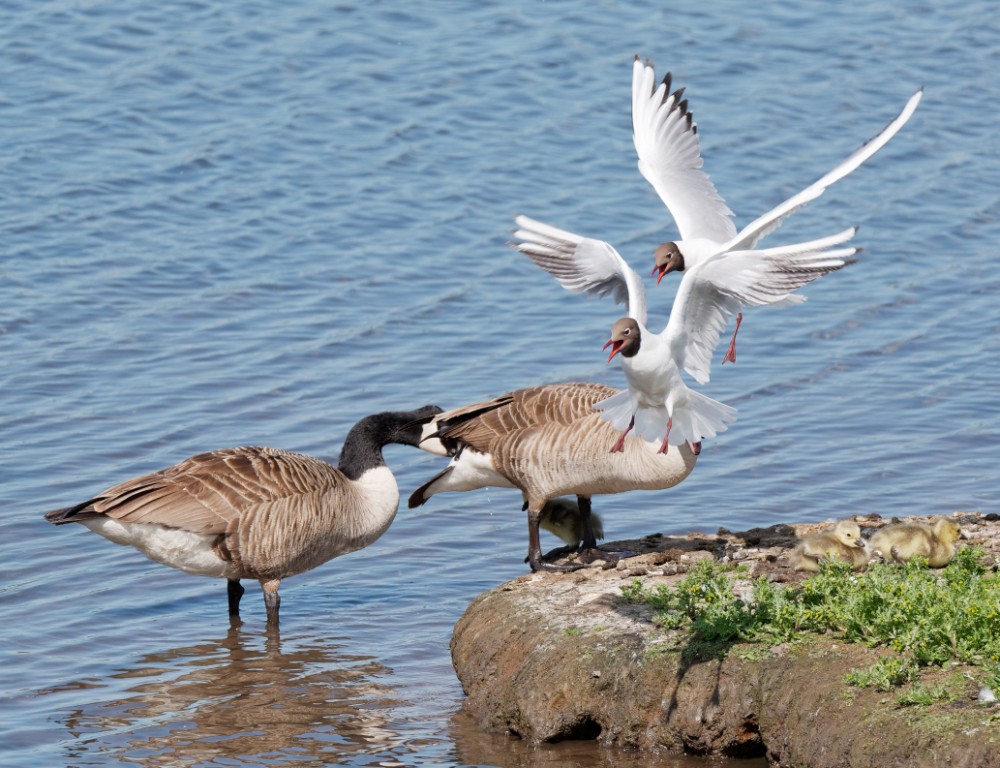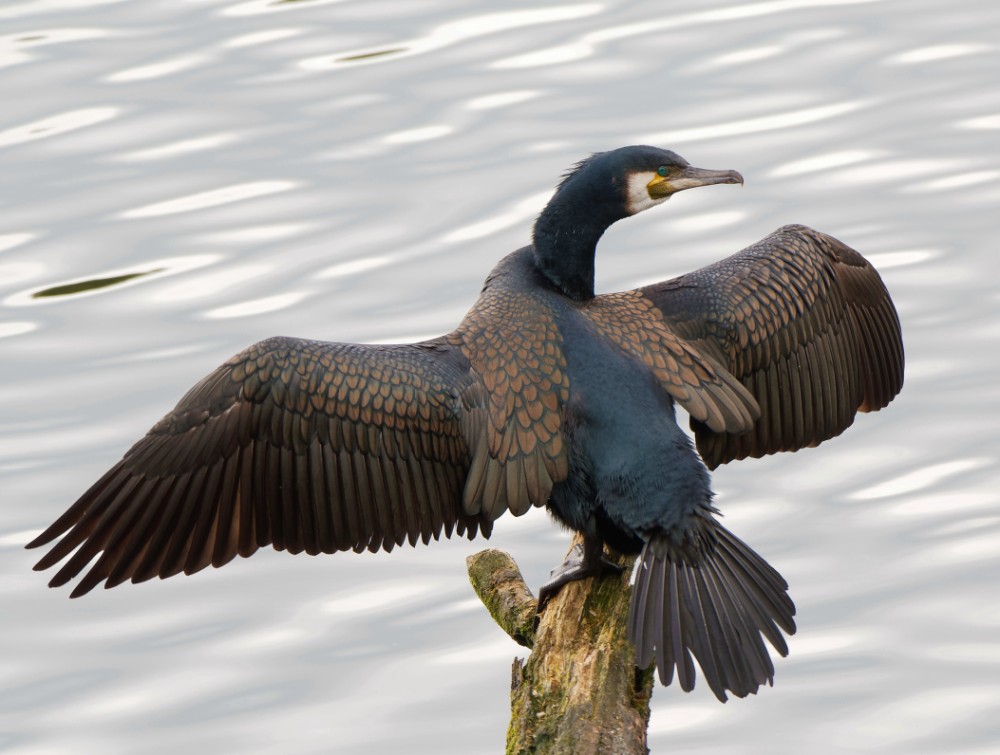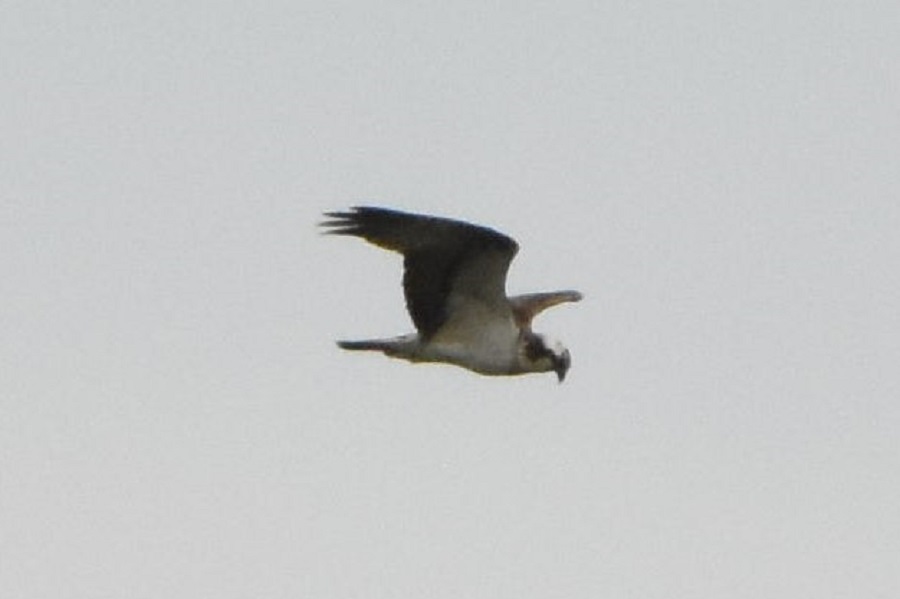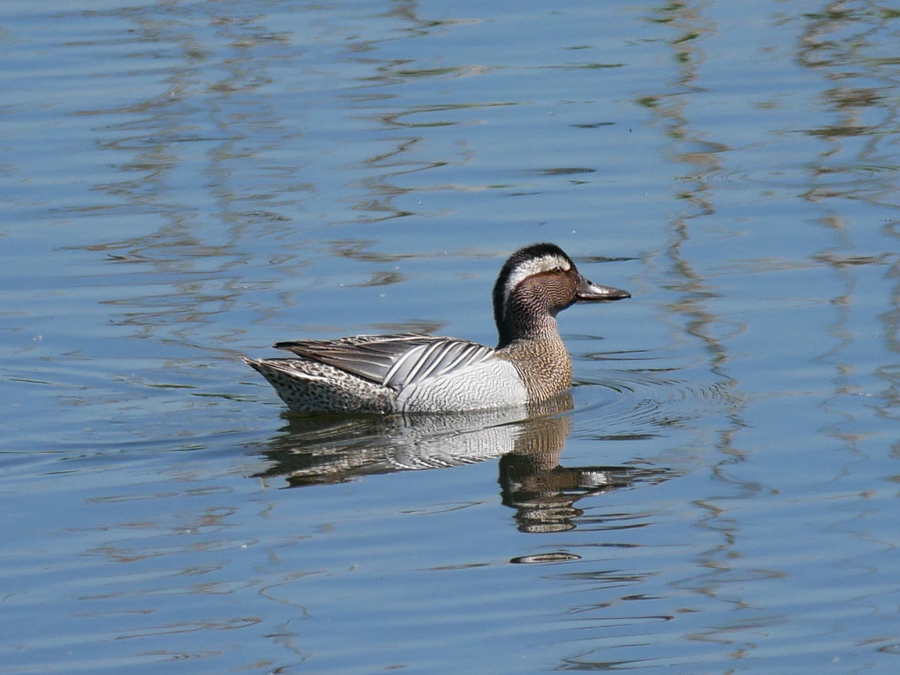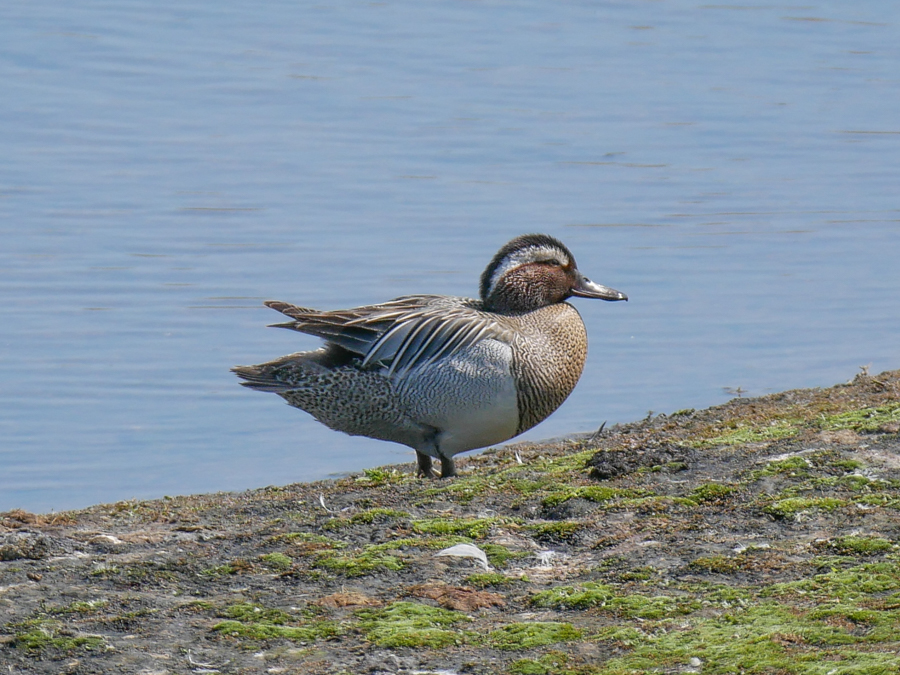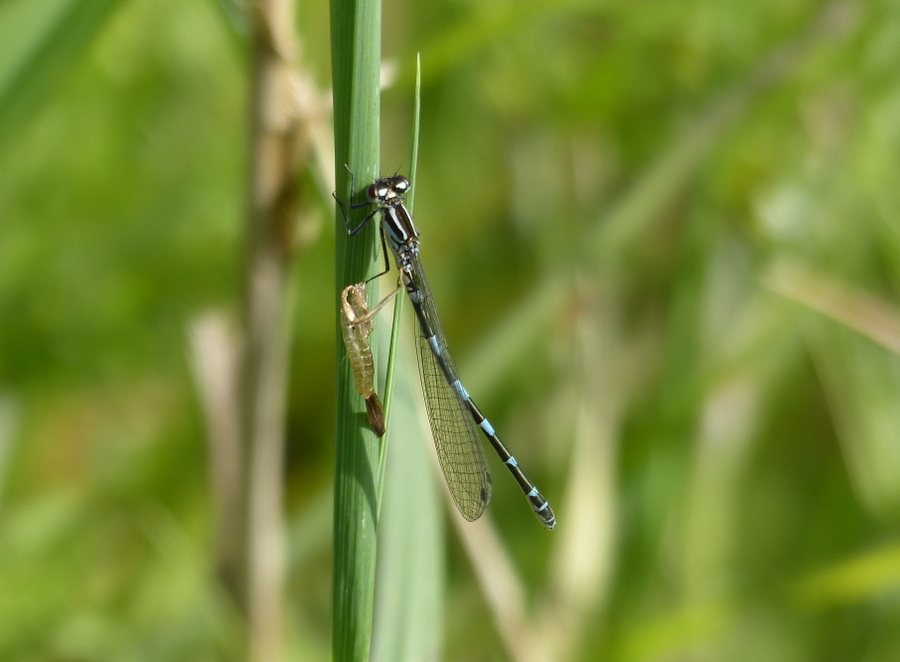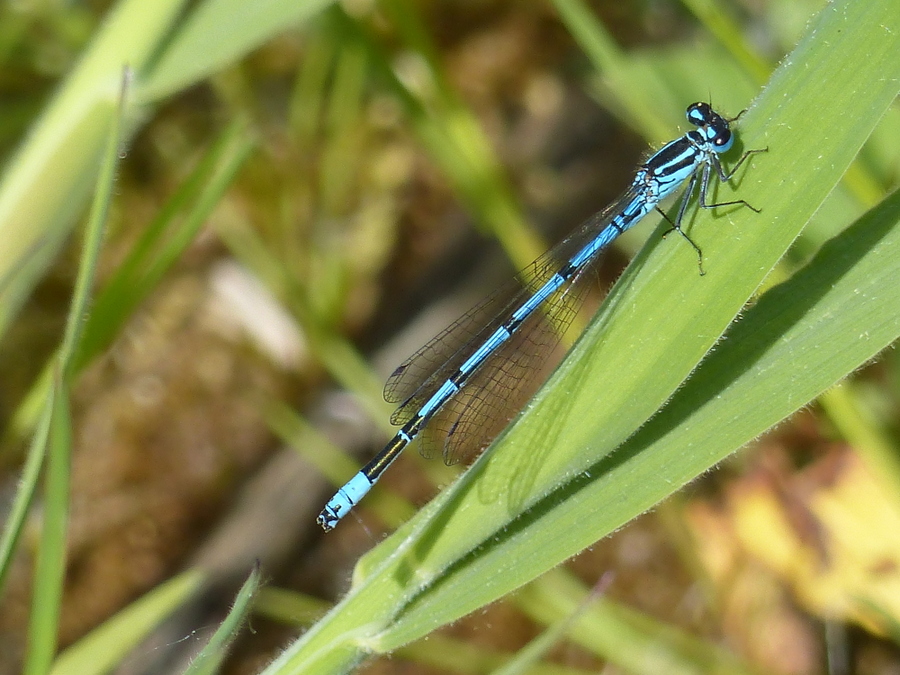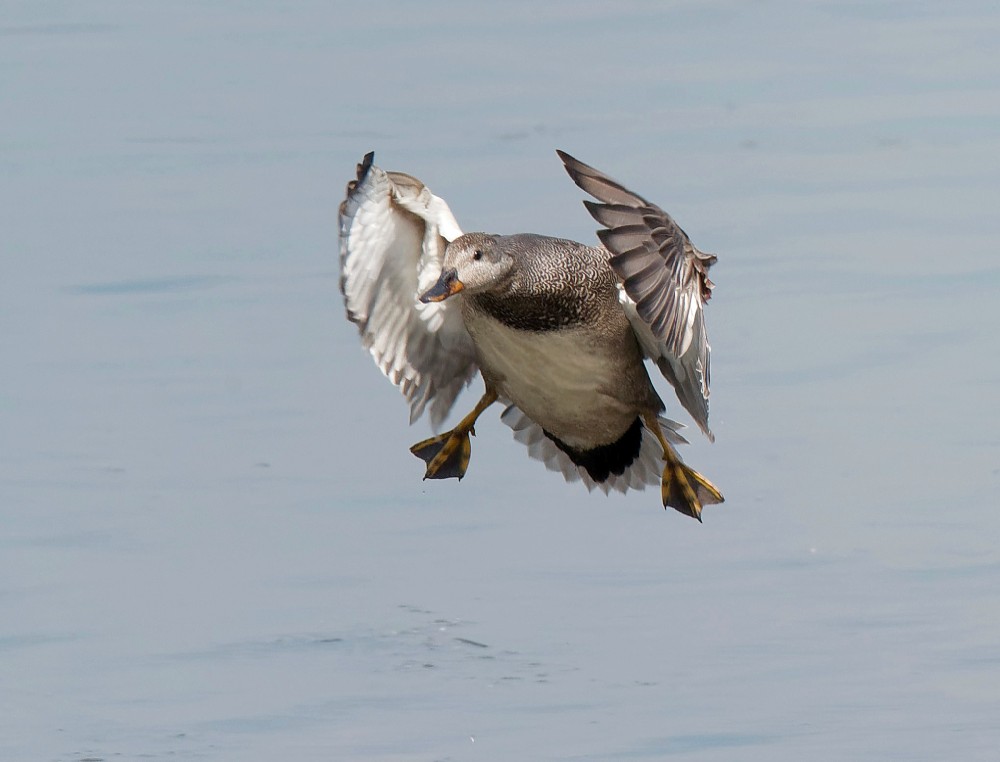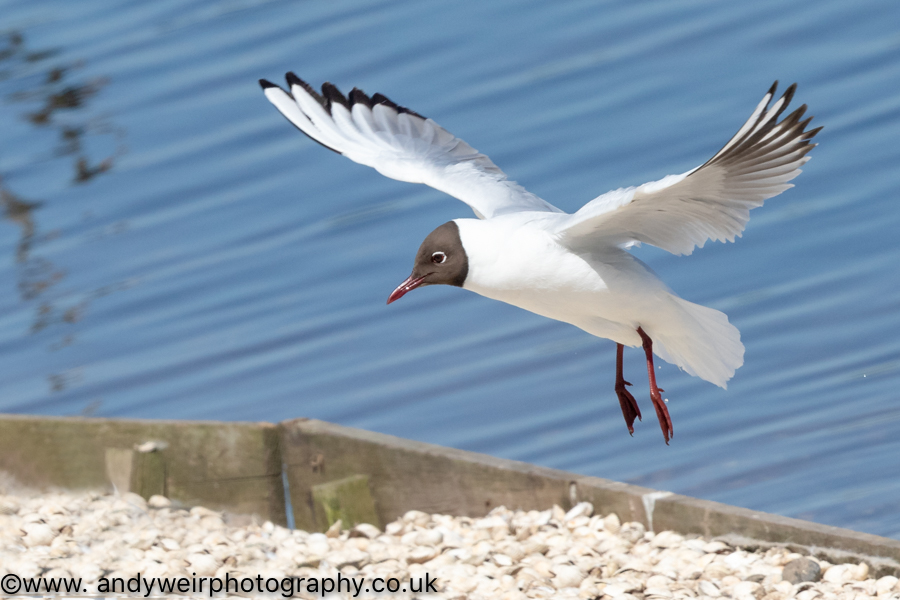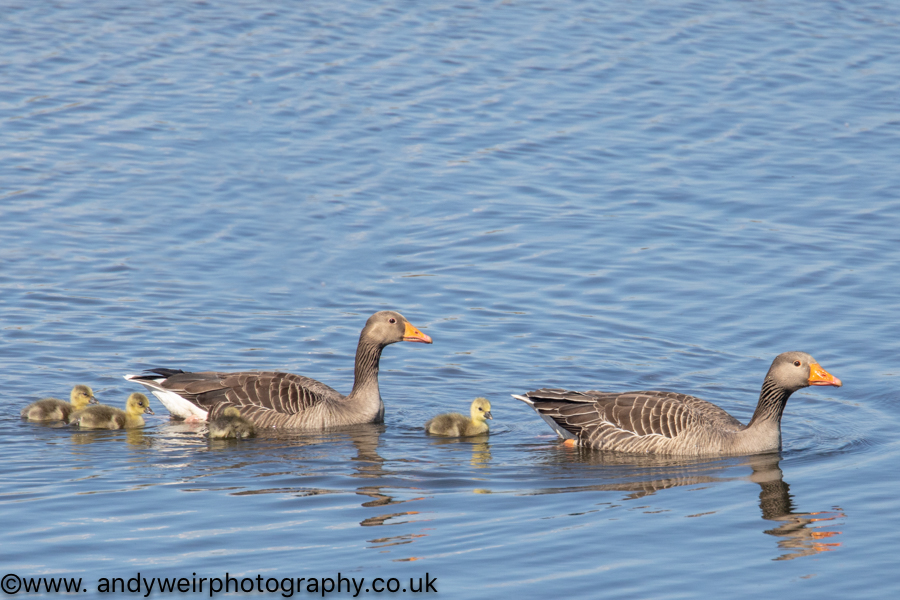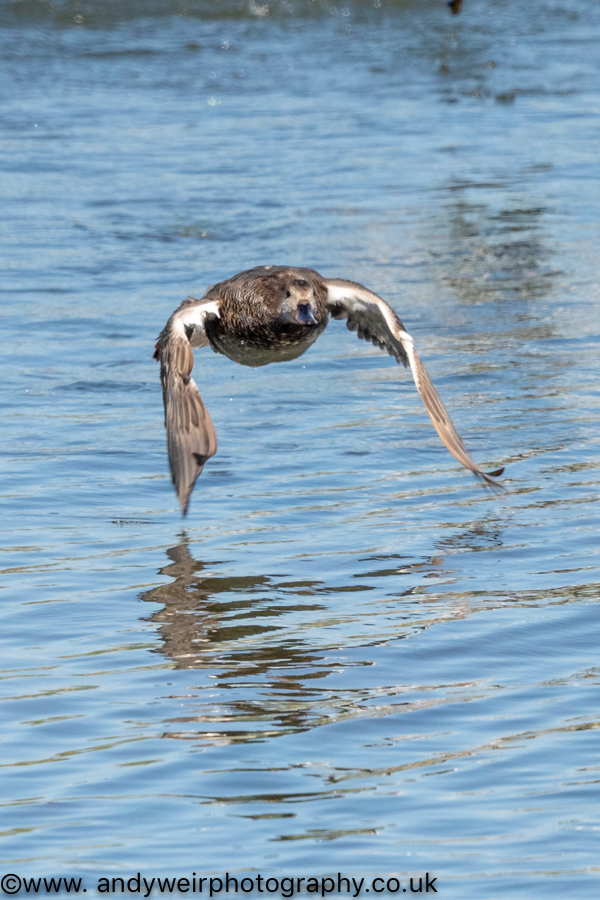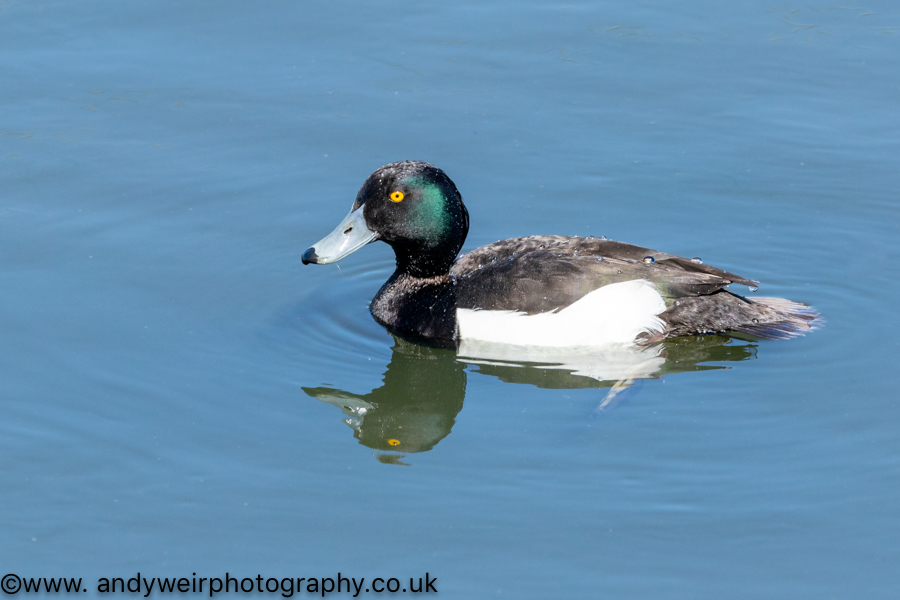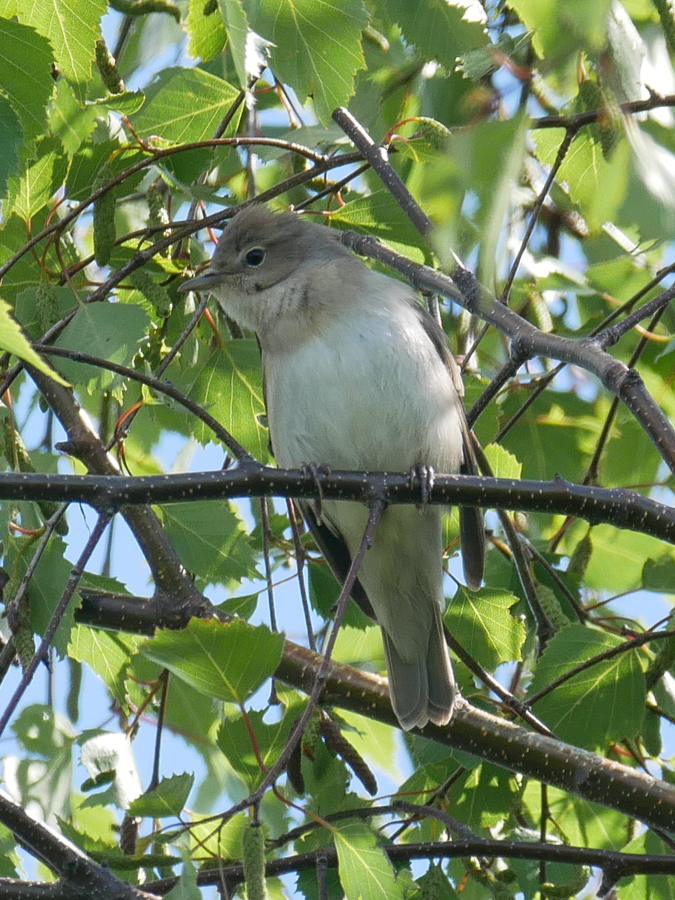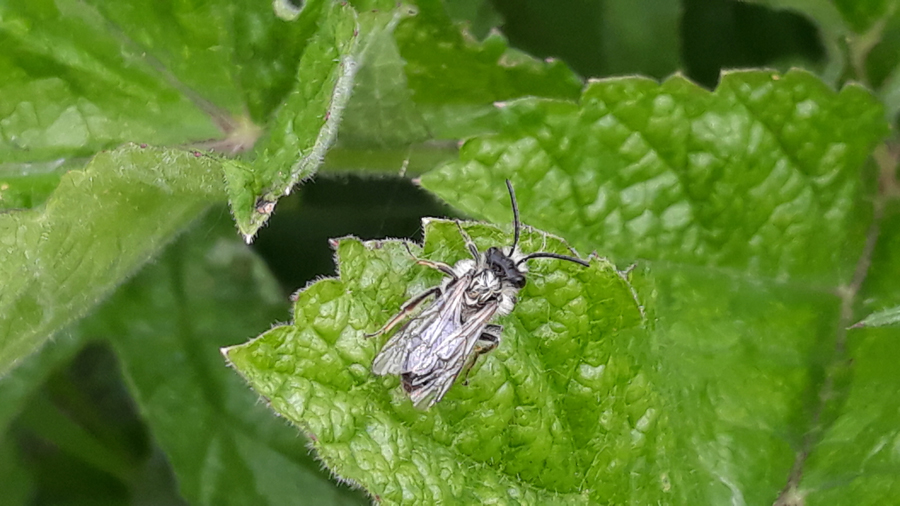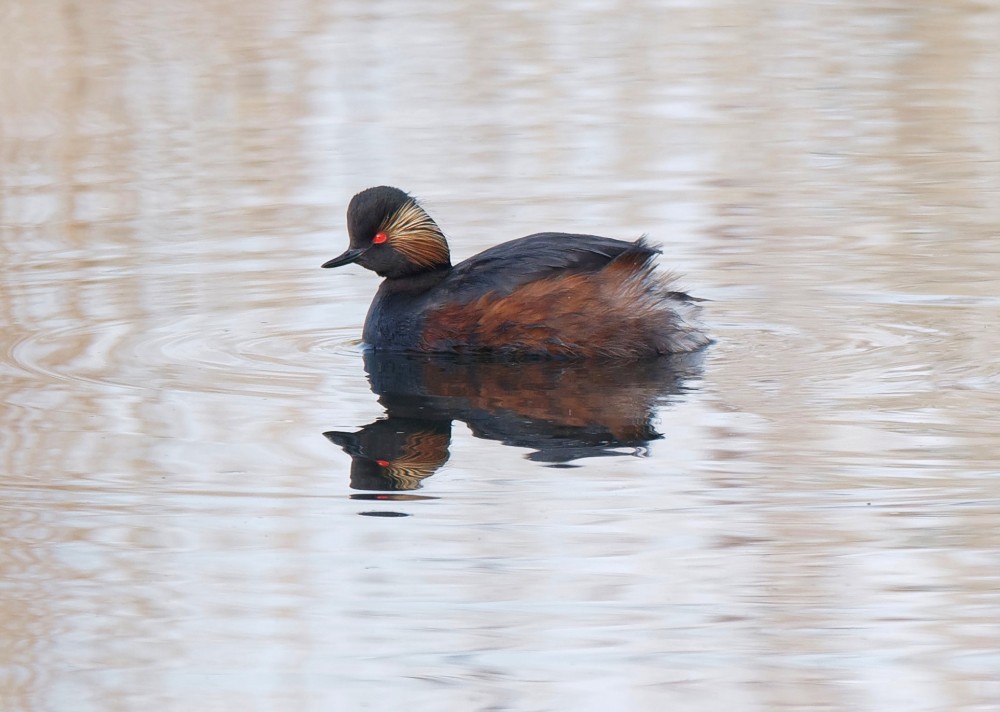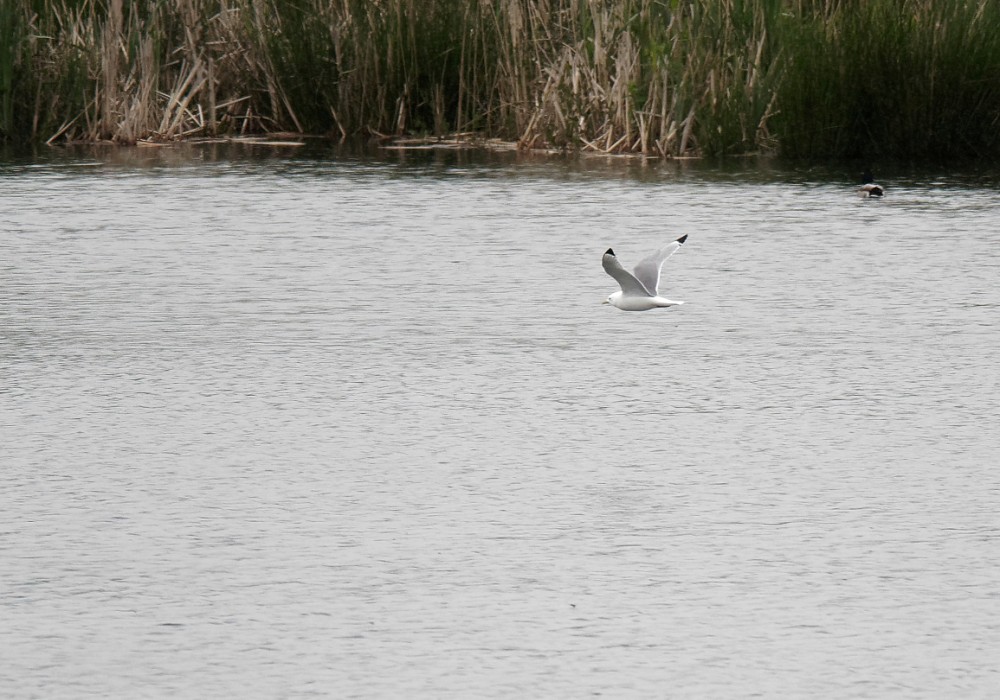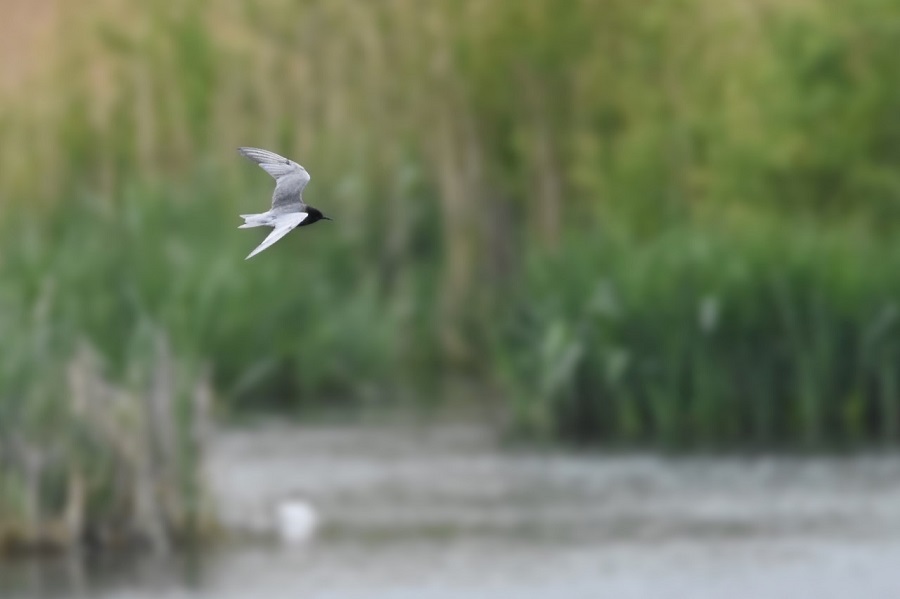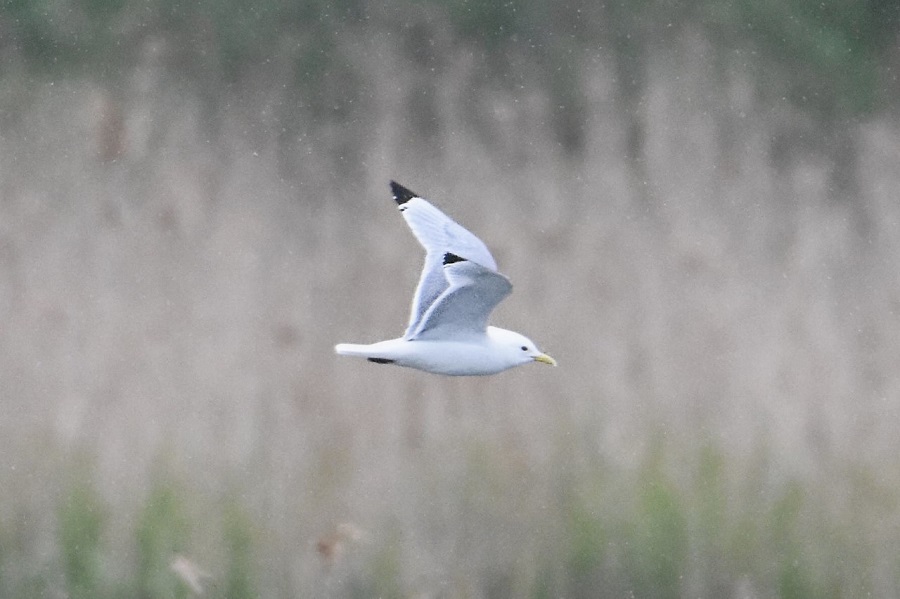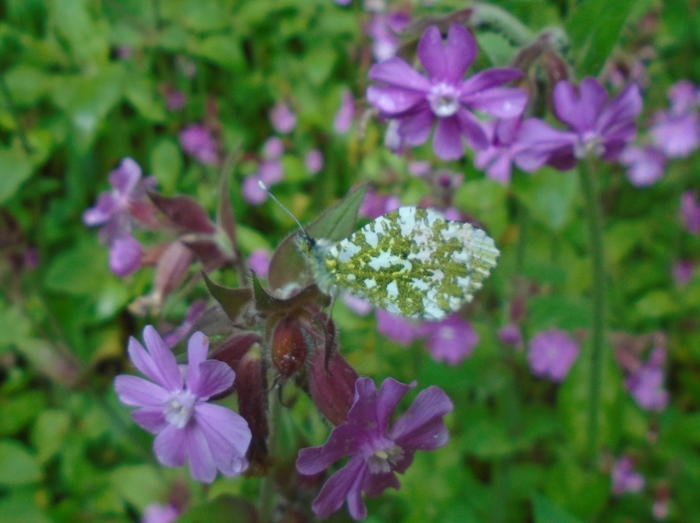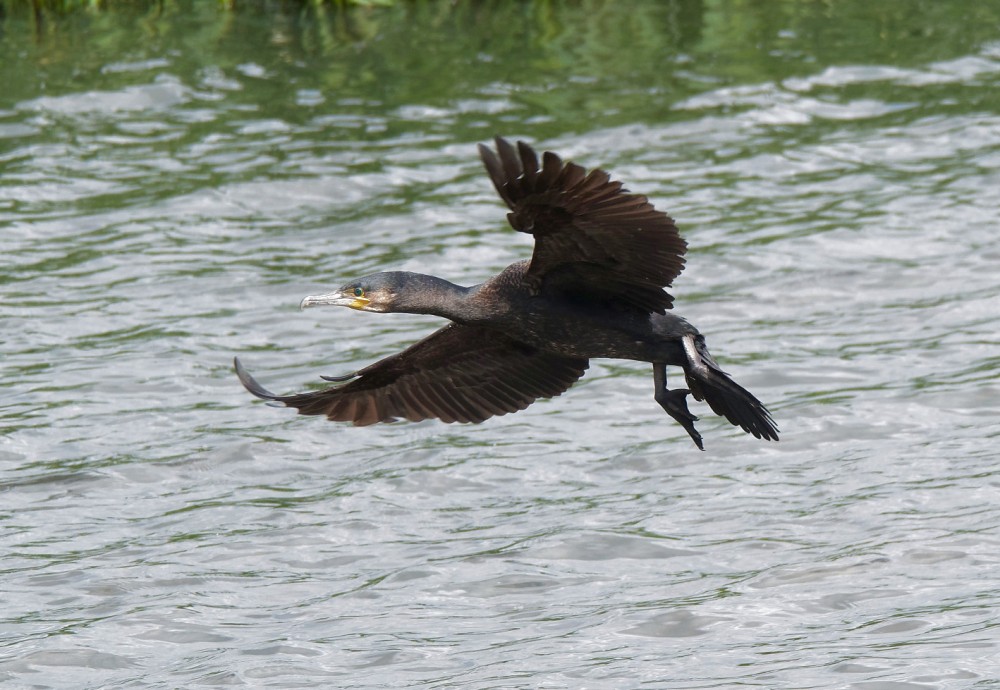Woolston Eyes Monthly Sightings
2019-05-30
On an overcast day, with the odd bit of drizzle and spring passage having tailed off, it was time to focus on our multitude of breeding birds. One of the Black-headed Gull nests on the Morgan Hide scrape is now holding three small young, while another 35 or so were out on the nest rafts. The Lapwing pair on the scrape were diligently brooding four eggs, though there’s still a long way to go. Interestingly, a pair of adult Mediterranean Gulls dropped in and seemed to settle well on the newest of the nest rafts. They are usually driven away by the breeding Black-headed Gulls but managed to find some unoccupied space on the new raft. If they do stay and breed it would be a first breeding record since the Reserve was established, forty years ago, as would be the Oystercatchers on No.1 bed. The scattering of Black-necked Grebes around the bed hopefully indicates an equivalent number of sitting females, with hatching surely close. Pochard have done well so far, and two broods were right in front of the hide, while Dave Hackett reported three large, new broods of Gadwall from the Mersey by No.1 bed, so, all in all, another excellent day. Photo of one of today’s Mediterranean Gulls Cheers David Bowman (with David Spencer, George Dunbar, Daniel Owen and Sue Haddock)
Submitted by: David Bowman
2019-05-29
Despite the slightly gloomy weather this afternoon, with the odd shower passing through, No.3 bed was a hive of breeding activity, with the odd migrant still passing through. A Common Sandpiper was on the Morgan Hide scrape when I arrived and then the resident female Cuckoo twice flew across the front of the hide. With at least one more present on No.1 bed, we have to be optimistic about the return of Cuckoo as a breeding species after a long hiatus. This adds to the good news of proved breeding for Oystercatcher (thanks to Mike Lloyd) for the first time since the 1940s (before my time, I hasten to add!). Willow Tits are having a good season, too, with seven successful nests located so far, by Mike Lloyd, Allan Rustell and Dan Gorner, with others still in progress. On the scrape, the resident Lapwings are on four eggs and one can only hope that they have better luck than with the previous two attempts. This week Pochard broods have started to appear, with five or six seen so far and the first Shelduck brood, of eight, also appeared. We are crossing our fingers that Black-necked Grebe broods will soon appear, as they are starting to be on the late side. The weather brought in good numbers of aerial feeders, with 65 Swifts, 45 Swallows, 25 Sand Martins and 16 House Martins skimming together over the water. Photo of a female Pochard Cheers David Bowman (with Danny Gornall)
Submitted by: David Bowman
2019-05-28
This young badger was foraging in the undergrowth immediately adjacent to the path around No.3 bed tonight. It was just a few feet from where I was standing but was unaware of my presence. It emerged onto the path and walked even closer towards me. When it finally saw me it arched its back, raising its fur and started grunting. Eventually it ran back along the path and into the central copse. Who needs Spring Watch!
Submitted by: David Spencer
2019-05-28
Great Crested Grebe with young in tow, swimming around the scrape today
Submitted by: Daniel Owen
2019-05-28
It’s not often the Black-necked Grebes come close enough for full-frame shots, this one taken from the John Morgan Hide this afternoon. A few more Pochard broods are starting to emerge, with at least two containing counts of double figure young - one of which with 17!
Submitted by: Daniel Owen
2019-05-27
A visit to the Loop of No.4 bed this morning on a cool day with a fresh north west wind revealed some good sightings from the hide. In many ways the sight of up to 40 feeding Swifts over the wetland was particularly welcome given the relatively small numbers reported across the country. Four broods of Coot 3 of 2 young and one of 4 fairly newly hatched. Two broods of Mallard and perhaps best of all a female Pochard with 7 newly hatched young.Two drake Pochard and a female were also on the water. Four pairs of Shelduck were resting on one of the islands where a sitting Black headed Gull is on a nest with a second pair looking interested nearby. Two pairs of Little Grebes seen one with a single chick; another Little Grebe was calling in the reeds. Four pairs of Tufted Duck on the water and up to 12 Gadwall. Two pairs of Canada Geese present one with a single gosling about 10 days old. in the Sandpit Pond area and west bank of No.4 8 Willow Warblers still in song and a male Cetti’s in song in the Loop reed bed. Two Lapwings were on one of the islands but no young seen.
Submitted by: Brian Martin
2019-05-25
Photo of one of three Black-tailed Godwits from No.3 bed this morning.
Cheers David
Submitted by: David Bowman
2019-05-25
With a 6.30 am start on No.3 bed, in calm conditions, it always felt like a morning when something a bit different might turn up. Early on, a Common Tern headed west in front of the Morgan Hide and then a Cuckoo made several flights out over the reed-beds, to perch in cover. From its behaviour, it was probably the female which has been seen daily recently, as they like to watch unobtrusively to find likely Reed Warbler nests in which to lay their eggs. With a male also present, calling near the entry barrier and a number of reports from No.1 bed, this is our best Cuckoo year in a long time. Two Peregrines, soaring over No.2 bed, were almost certainly our resident breeding pair and they were then followed by two soaring Hobbies. Waders were represented by an Oystercatcher, which dropped onto the scrape, and three Black-tailed Godwits, which circled the bed several times before heading north-west on the long journey to their Icelandic breeding grounds. Other sightings of note included 70 Swifts passing through, more than 50 Black-headed Gull chicks, one of the resident Mute Swan pairs with seven young and one of the many Black-necked Grebes present feeding just below the Morgan Hide (see photo!). Cheers David Bowman (with David Spencer, Helen Wynn, Alan Warford and Brian Baird)
Submitted by: David Bowman
2019-05-23
Black-headed Gull (Chroicocephalus ridibundus) from John Morgan Hide
Submitted by: Andy Weir
2019-05-22
A pleasant morning, starting by showing Colin Pringle, from the RSPB, around the Reserve in company with his colleagues Graham Jones and Danny Gornall. On the walk over to the Loop of No.4 bed two Willow Tits were good to see, as they can be elusive once they have started nesting. This bed holds at least 12 pairs and the Reserve is one of the national strongholds for this rapidly declining species. On the Loop itself a single Black-headed Gull was on a nest - one of our ambitions is to establish a Black-headed Gull colony on the Loop, so maybe this is the start of something good. Danny’s sharp eyes then picked out a female Wigeon skulking near the reeds. Interesting because Wigeon aren’t usually present here in the breeding season. On the way back, two Common Blue butterflies were good to see. Then, walking onto No.3 bed, the long-staying male Garganey was visible from the South Screen. From the Morgan Hide, 36 Black-headed Gull chicks were on the nest rafts and the Lapwing pair on the scrape were again mating and exploring possible nest scrapes, despite several recent failures. The drive to reproduce is a powerful thing, as evidenced by an immature Black-headed Gull which repeatedly mated with a dead gull on the scrape - the Jimmy Saville of the bird world (or is that in bad taste?). Best of all, though, was the female Cuckoo, which flew within a few feet of the Morgan Hide, looking stunning in the sunshine. Photo of a Shelduck from today. Cheers David
Submitted by: David Bowman
2019-05-21
Mediterranean Gull that briefly dropped onto the scrape this lunchtime
Submitted by: Daniel Owen
2019-05-21
In warm sunshine and with a light north-westerly blowing, little migration was evident on No.3 bed today. Just a few Swifts and hirundines moved through, followed in mid-afternoon by a Hobby. Under those conditions it’s more profitable to be looking for water-bird broods, with particular focus on two of our scarce/rare breeders, Black-necked Grebe and Pochard. While there was a good scattering of grebes, no broods were spotted, though they should appear any day now. I was more successful with Pochard, re-locating a brood of four in the north-east channel and finding another of three in front of the Rotary Hide. Black-headed Gull activity is reaching a crescendo, with 20 small young already on the nest platforms and many scores of adults on eggs, mating or nest-building around the bed. The Morgan Hide scrape has become a high-risk environment for breeding gulls and Lapwings, due to the presence of Greylag and Canada Geese. We’ve already watched Greylags predating eggs from Lapwing nests and today, a pair of Canadas with young pushed a sitting Black-headed Gull off its nest, despite sustained mobbing and proceeded to trample over the nest site (see photo). Its a tough life out there! Cheers David Bowman
Submitted by: David Bowman
2019-05-18
An early start on No.3 bed began well, with a drake Garganey skulking around the reeds at the back of the bed. A trip on to No.1 bed then confirmed breeding for the Peregrine pair under the Viaduct, with the female brooding small young, as well as for a pair each of Swallow and Grey Wagtail, which were entering nest sites under the piers. Meanwhile, back on No.3 bed, a flurry of wader activity produced fly-throughs by 37 Black-tailed Godwits and 4 Oystercatchers. Two other records of note were of a female Pochard with five small young, our first Pochard brood of the season and a Skylark in song over the centre of the bed, reported by Kieran Foster, an unusual potential breeding record for the Reserve.
Photo of a Cormorant from this morning.
Cheers David Bowman (with David Spencer, Helen Wynn, Alan Warford, Sue Haddock, Les Jones and Brian Baird)
Submitted by: David Bowman
2019-05-17
Photo of the Osprey that headed South over No.3 Bed, seemingly following the River Mersey before cutting across the reserve toward the Canal. Marsh Harrier and Cuckoo were also present today.
Submitted by: Daniel Owen
2019-05-17
Photo of the Garganey which has been visiting the scrape over the last few days
Submitted by: David Spencer
2019-05-15
Photo of freshly emerged female Azure Damselfly with Exuvia still present on No.1 bed today.
Submitted by: Brian Baird
2019-05-15
The first Azure Damselflies were present today. Photo of a male on No.1 bed.
Submitted by: Brian Baird
2019-05-13
It was one of those hot, somnolent, late spring days on No.3 bed, with not much moving but plenty of breeding activity in evidence. The first Great Crested Grebe young were riding around on their parent’s backs, a handful of Black-headed Gull chicks were being brooded on the nest rafts, and broods of Greylag Goose, Canada Goose, Mallard and Coot were sailing around the bed. When things are quiet it’s nice to take a few photos of the common birds or of the increasing numbers of emerging insects. My first Four-spotted Chaser dragonfly of the year was patrolling the south bank and there were plenty of small beetles, bees and hoverflies around.
Photo of a drake Gadwall
Cheers David Bowman
Submitted by: David Bowman
2019-05-12
Black-headed Gull (Chroicocephalus ridibundus) from Vikki’s shell Island, John Morgan Hide
Submitted by: Andy Weir
2019-05-12
2019 is proving a good year for Gardens Warblers with at least 8 singing males including this showy individual along the footpath between the weir and Ship Canal (near the old screen).
Submitted by: David Spencer
2019-05-11
Grey Mining Bee - Andrena cineraria. also known as Ashy mining bee this is a first for me on No3 Bed
Submitted by: Keith Gallie
2019-05-11
Another stunning morning on No.3 bed, starting at 6.30 am and managing to complete both a Breeding Wildfowl Survey and a combined Common Bird/Breeding Warbler Survey. After that, it was relaxing in the Morgan Hide and seeing what we could find. Highlights of the day were a Cuckoo, which flew across the North Meadow, a Hobby hunting over the North Bank, A marauding Peregrine, a couple of Ravens, 18 Black-necked Grebes (with more, no doubt, on nests), a single Garden Warbler (though we have found eight territories across the whole Reserve), an influx of Reed Warblers, 75 Swifts and among the commoner breeding wildfowl, evidence for at least three breeding pairs each of Shoveler and Teal. All in all, an excellent day.
Photo of a Black-necked Grebe
Cheers David Bowman (with David Spencer, Helen Wynn, Alan Warford, Brian Baird, Les Jones and Damian Smith)
Submitted by: David Bowman
2019-05-09
With low cloud, a light northerly wind and intermittent drizzle, it looked good for migrant terns today. I was in the Morgan Hide by 5.30 am, to be greeted by a passing Redshank. The Lapwings on the scrape have now had their third set of eggs predated, presumably by some of the local Greylags, based on previous observations. At 7.00 am, Dave Steel and I set off to do a breeding bird survey of No.1 bed, highlights of which were: 2 pairs of Little Ringed Plover and 4 pairs of Lapwing, while singing birds included: 10 Reed Warblers, 14 Willow Warblers, 4 Blackcaps, 5 Chiffchaffs, 6 Whitethroats and 23 Wrens. Meanwhile, back on No.3 bed, singles of Dunlin and Oystercatcher had flown through. Back in the Morgan Hide, increasingly heavy showers then brought down two Common Terns, followed by a Kittiwake and two Black Terns (the latter two picked up by the sharp-eyed Daniel Owen!), while a Hobby also made frequent passes over the bed. My kind of day.
Record shot of one of the Black Terns
Cheers David Bowman (with David Spencer, Dave Steel, Daniel Owen, George Dunbar and Sue Haddock)
Submitted by: David Bowman
2019-05-09
The rain and easterly winds certainly delivered today, with 2 Common Terns and a Dunlin through No.3 Bed early giving hope of things to come. This was realised when a Kittiwake passed through, before being chased away by the Black-headed Gulls. 2 Black Terns followed suit shortly after before heading NW above the tree line – all in all another brilliant day at Woolston
Submitted by: Daniel Owen
2019-05-05
A lovely early morning in spite of the low temperature. I carried out a common bird survey on the northern half of No.4 bed which produced some excellent totals, much higher than in 2018. These included 35 Blackcaps, 15 Chiffchaffs, 6 Willow Warblers, 32 Whitethroats, 19 Robins, 21 Wrens, 14 Pheasants, 15 Song Thrushes, 9 Blackbirds, 4 Reed Warblers and singles of Garden Warbler, Cetti’s Warbler, Sedge Warbler and Reed Bunting. Most of the above were singing males. Photo; male Orange Tip taken on Friday.
Submitted by: Dave Hackett
2019-05-04
Today, in brilliant sunshine but with an increasingly cool northerly wind blowing, there was an excellent passage of aerial feeders. As ever, when there are plenty of hirundines around, a marauding Hobby appeared and made a few passes over No.3 bed before soaring off to the east. Totals over the morning included: 80 Swifts, 600 House Martins, 165 Swallows and 140 Sand Martins. Other activity included an estimated 140 breeding pairs of Black-headed Gulls (including two pairs with eggs on the Morgan Hide scrape), two singing Lesser Whitethroats (along the Canal Track), two Sedge Warblers, one Raven and the Lapwing pair in front of the Morgan Hide, which now has three eggs. Photo of an incoming Cormorant from this morning.
Cheers David Bowman (with David Spencer, Helen Wynn, Alan Warford, Les Jones, Sue Haddock, Brian Baird and Dave Steel)
Submitted by: David Bowman


